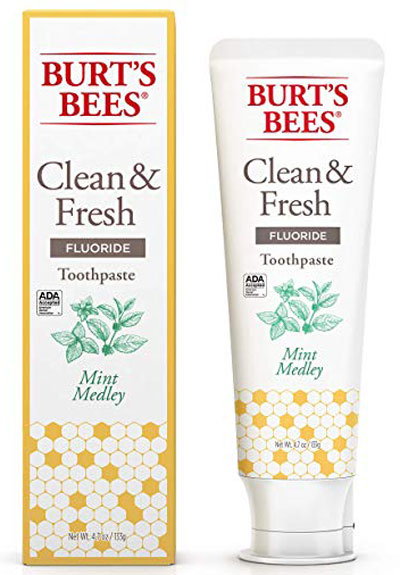Burt’s Bees Hopes Third Time’s A Charm In Oral Care With P&G As Provider
Executive Summary
Clorox and Procter & Gamble embarked on a strategic licensing partnership to market Burt’s Bees toothpastes, available now in mass retail doors. Billed as simple formulas for adults and kids, with or without fluoride, the line marks the third swing at toothpaste for the iconic natural brand.
[Clorox Co.]’s Burt’s Bees is taking another stab at the toothpaste category, this time through a licensing partnership with Procter & Gamble Co., marketer of the Crest oral care product line.
"Oral care is a natural extension of the existing Burt’s Bees product offerings and extends the commitment to bring simple, naturally inspired products to consumers,” Burt’s Bees says in a fact sheet about the launch of its line of adult and children’s products.
It’s not the natural pioneer’s first foray into oral care. Burt’s introduced Lavender Mint Toothpaste under its Doctor Burt’s sub-brand in the early 2000s. (Also see "International Gift Fair In Brief" - HBW Insight, 28 Jan, 2002.)

Following its acquisition by Clorox, Burt’s followed up with a six-paste range in 2010 – the first to be certified natural by the Natural Products Association, it said – but the line was phased out that same year due to “various market dynamics,” according to a P&G spokesperson. (Also see "Burt's Bees Targets Oral Care, Launching First NPA-Certified Toothpastes" - HBW Insight, 22 Mar, 2010.)
P&G offered limited detail on the licensing agreement’s terms, but the Cincinnati-based consumer goods giant is manufacturing the new Burt’s line and could provide marketing expertise and international distribution opportunities to Clorox, which began as a liquid bleach manufacturer in the early 1900s and went on to diversify its offering beyond household and professional cleaners with brands including Hidden Valley ranch dressing and Brita water filters.
Oakland, Calif.-based Clorox snapped up Burt’s in 2007 for $925m, a deal that analysts saw as a clear sign that “natural” had arrived to the mainstream, while also inviting skepticism from some who questioned the pairing. (Also see "Clorox’s Purchase Of Burt’s Bees Confirms Arrival Of Naturals To Mainstream" - HBW Insight, 5 Nov, 2007.)
In 2018, Clorox expanded its portfolio with Rainbow Light vitamins, Natural Vitality anti-stress and sleep supplements and Neocell supplements for hair, skin and nails via a $700m purchase of Nutranext LLC. (Also see "Clorox Did Homework On Becoming 'Emerging' Supplements Leader Before Buying Nutranext" - HBW Insight, 2 May, 2018.)
Five Choices In Toothpastes
The Burt’s Bees toothpaste line, available in drug and grocery stores, mass merchandisers and online, consists of:
-
Purely White Zen Peppermint (fluoride-free);
-
Enamel Care Mountain Mint (with fluoride);
-
Clean & Fresh Mint Medley (with fluoride);
-
Kids Fruit Fusion (with fluoride or fluoride-free).
The formulas are free of sodium lauryl sulfate, triclosan and parabens, are not tested on animals and come in cartons containing 65%+ post-consumer recycled plastic. The adult products are priced at $6 and the children's options at $4 on the brand's website.
For P&G, the Burt’s toothpaste deal builds on its push into the naturals segment. Chief Financial Officer Jon Moeller noted during an earnings call in February that the company is focusing on developing or acquiring additional natural offerings to “increase the relevance” of its brands and products. (Also see "P&G taking natural path" - HBW Insight, 2 Feb, 2018.)
In 2017, P&G scooped up the Native direct-to-consumer deodorant brand for a reported $100m, growing its natural stake in a category where it competed already with Gillette, Old Spice and Secret deodorant/antiperspirants. (Also see "P&G Goes Native In Acquisition That Aligns With Peltz' Vision" - HBW Insight, 28 Nov, 2017.)
P&G also has been growing its dietary supplement market presence. In 2018, it acquired Merck KGAA’s global consumer healthcare business, including the Femibion women’s health line and the Seven Seas cod liver oil range. The firm closed the €4.5bn ($5.2bn) cash deal in late November. (Also see "P&G signals its intent with Merck acquisition " - HBW Insight, 27 Apr, 2018.)
The additions joined P&G’s Metamucil fiber line and Align probiotics.
According to Burt's Bees' website, a number of protein supplements for "healthy radiance" and gut health have been discontinued by the brand.
It continues to market skin, lip, body and hair care products and makeup for mothers and babies. Reportedly, P&G and Clorox could consider collaborations in other Burt's Bees product segments.
A P&G representative said the formulations the firm is providing for Burt's Bees s have been benchmarked against competitor formulas. “Consumers rated them higher in overall taste, freshness and clean,” she said without providing survey results in full.
“We know that 35% of people in the US are interested in using simple and effective formulas, but only 5% of that group are buying the products today. Many consumers feel there are trade-offs with the current product offerings in this segment,” she said.
Clorox’s relationship with P&G traces back more than half a century. P&G acquired the company in 1957 when it was a mere 370-person operation – it now employs close to 9,000 – but was forced to sell Clorox after a decade-long legal battle due to anti-trust concerns. (Also see "Clorox’s Purchase Of Burt’s Bees Confirms Arrival Of Naturals To Mainstream" - HBW Insight, 5 Nov, 2007.)
The firms teamed up in 2003 with a joint venture around Glad and GladWare food and trash bags and storage containers. In 2004, P&G paid Clorox $133m to increase its stake in the arrangement from 10% to 20%.
From the editors of HBW Insight.
